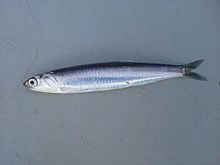European anchovy
| European anchovy | |
|---|---|
 |
|
| Scientific classification | |
| Kingdom: | Animalia |
| Phylum: | Chordata |
| Class: | Actinopterygii |
| Order: | Clupeiformes |
| Family: | Engraulidae |
| Genus: | Engraulis |
| Species: | E. encrasicolus |
| Binomial name | |
|
Engraulis encrasicolus (Linnaeus, 1758) |
|
The European anchovy (Engraulis encrasicolus) is a forage fish somewhat related to the herring. Anchovies are placed in the family Engraulidae.
It is easily distinguished by its deeply cleft mouth, the angle of the gape being behind the eyes. The pointed snout extends beyond the lower jaw. The fish resembles a sprat in having a forked tail and a single dorsal fin, but the body is round and slender. The maximum length is 21 cm (8 1⁄8 in).
European anchovies are abundant in the Mediterranean and formerly also the Black and Azov seas (see below). They are regularly caught on the coasts of Bulgaria, Croatia, France, Georgia, Greece, Italy, Albania, Romania, Russia, Spain, Turkey and Ukraine. The range of the species also extends along the Atlantic coast of Europe to the south of Norway. In winter it is common off Devon and Cornwall (United Kingdom), but has not hitherto been caught in such numbers as to be of commercial importance.
Formerly they were caught in large numbers off the coast of the Netherlands in summer when they entered the Wadden Sea and Zuiderzee. After the closing of the Zuiderzee they were still found in the Wadden Sea until the 1960s. They were also caught in the estuary of the Scheldt.
...
Wikipedia

